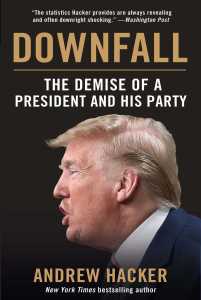
The Proud Boys in Washington last month. Photo (cc) 2020 by Geoff Livingston.
Previously published at GBH News.
And so today, at least for a few hours, we descend once again into the madness.
The past four days have been as dizzying as anything we’ve experienced as a nation, and would be seen as such if we hadn’t been dealing for the past four years with the terrible consequences of electing Donald Trump as president in 2016.
On Sunday, we learned that Trump had tried to muscle Georgia’s top election officials into awarding him the state in his ongoing efforts to overturn the results of the November election — surely an impeachable offense, and most likely a federal and state crime as well.
But life as we have come to know it during the Trump era rolled on. Republicans on Capitol Hill continued with their seditious plot to supersede the Electoral College, a tragicomedy upon which the curtain will rise later today. Thousands of MAGA protesters are arriving in Washington to urge them on. Meanwhile, the COVID pandemic is out of control, the economy remains in shambles and we learned once again that police officers can shoot a Black man in the back without much in the way of consequences.
And yet.
On Tuesday evening, not long after the polls had closed in Georgia, it started becoming clear that we may be in for a period of — what? Not normality. The radical right, as Washington Post media columnist Margaret Sullivan has properly suggested we label the MAGA wing of the Republican Party, won’t allow for that. But relative calm at least.
It may be no exaggeration to say that the outcome of the George Senate runoff elections was as crucial to our survival as a constitutional republic as the outcome of the presidential election two months ago. As of early this morning, the Rev. Raphael Warnock has defeated the Republican incumbent, Kelly Loeffler, for one of the seats, and the other Democratic challenger, Jon Ossoff, appears likely to be declared the winner in his race against Sen. David Perdue.
With Warnock’s and Ossoff’s victories comes control (barely) of the Senate. Though each party will hold 50 seats, the incoming vice president, Kamala Harris, will be able to break tie votes. That would be a big deal in any case, but it looms even larger given the dangerous abyss into which the Republican Party has fallen.
At the liberal website Talking Points Memo, Josh Marshall writes that “it allows Joe Biden to assemble a government. I think people have been underestimating the likelihood that a Republican senate would simply refuse to confirm major Biden appointees, forcing the President to try to wing stuff together with recess and vacancies act appointments that would themselves become tied up in the courts.”
We can’t underestimate what Biden will be up against once he’s sworn in. On Tuesday night I spent about an hour and a half watching Newsmax, which, along with OANN, has stolen a large chunk of the MAGA audience from Fox News because the journalists at Fox have remained at least somewhat tethered to reality.
Not long after the polls closed, Newsmax analyst Mark Halperin (remember him?) said that if the exit polls were “close to accurate,” then the Republicans would win. But an hour or so later, as it started to become clear that Republican turnout in Georgia wasn’t going to be enough to keep Perdue and Loeffler in office, the talking heads started to lay out the case that the results would be illegitimate.
For instance, Dick Morris (remember him?) took solace in figures that showed about 2 million early voters in Georgia had done so in person whereas just 1 million had voted by mail. “It’s a lot easier to fake mail-in voting than in-person voting,” he said, dumping a few buckets of poison into the well.
Another guest, U.S. Rep. Mo Brooks, R-Ala., a leader of today’s rebellion against reality, actually called on the Senate not to seat Warnock and Ossoff even if they won. “It’s one thing for those ballots to be accurately counted; it’s another thing as to whether those ballots are legal,” he said, claiming without any evidence that there were “a massive number of illegal ballots in the system.”
Former Trump aide Sebastian Gorka (remember him?) tied the Senate race and the presidential election together by claiming “election fraud and quote unquote irregularities” and citing disproven allegations of votes being “pulled out from under tables.” Gorka also demonstrated a Trumpian facility for childish insults, calling Ossoff a “milquetoast Beto” and a “Justin Trudreau knockoff” and Warnock an “utter, utter radical.”
We can’t underestimate the effect of all this on the 40% of the public that remains in thrall to Trump and Trumpism. Whereas elite conservatives like Rich Lowry (“Republicans have likely lost control of the Senate, but will have the consolation prize of being able to marinate for hours tomorrow in delusional schemes”) and Tom Nichols (“the majority of the Republican Party and its apologists are advocating for the overthrow of an American election and the continued rule of a sociopathic autocrat”) rage against the president, Trump’s supporters have directed their own rage at the legitimately elected government of the United States.
Or as the pro-Trump conspiracy site Gateway Pundit puts it: “Pray for Vice President Pence to make the correct decision and save our nation from corrupt banana-republic elections that will undoubtedly be our future if this election is allowed to stand.”
Today’s attempted coup will end in failure. According to most reports, there will be more than enough Republican senators who’ll join with their Democratic colleagues to stop the madness. And if that doesn’t work, the Democratic House will put an end to it. But even with Republicans out of power in the House, the Senate and the presidency, we remain in a dangerous moment.
“America is in a precarious spot,” writes Boston College history professor Heather Cox Richardson. “But Americans have finally woken up. Democracy is not a spectator sport, and people are now speaking up, demanding that our leaders listen to us, and insisting that officials as well as ordinary Americans answer to the law.”
Crucial to navigating that future will be the role of the media. New York University journalism professor Jay Rosen argues that much of the press would like nothing better than a return to the good old days — Democrats versus Republicans, balance and a retreat from the activism it embraced during the worst of the Trump presidency.
“Powerful forces favor a restoration,” Rosen writes. “It is by far the most likely outcome. After coping with an avalanche of news, an excess of controversy, and a hate campaign against them for five years, journalists would no doubt welcome a return to regular order, and a more human pace.” He adds: “Trump screwed with the ‘both sides’ system by busting norms and lying all the time, but that has only increased the longing to have the old constructs back.”
In theory, I agree with Rosen that the media can’t go back to the way things were. In practice, I’m not sure what that looks like. Already, I’ve seen pushback against normal journalistic vetting such as Politico’s recent story about the millions of dollars in corporate speaking fees earned by Biden’s choice for treasury secretary, Janet Yellen. I’m sorry, but that’s a perfectly fine story as long as we don’t make too much of it.
What I’d like to see is a refusal to take the Republicans’ bait on phony Democratic scandals (Hunter Biden, anyone?); a willingness to cover the Republicans in good faith when they act in good faith, but an equal willingness to denounce radical measures not based in reality; and an unwavering defense of democracy.
Fourteen more days.








